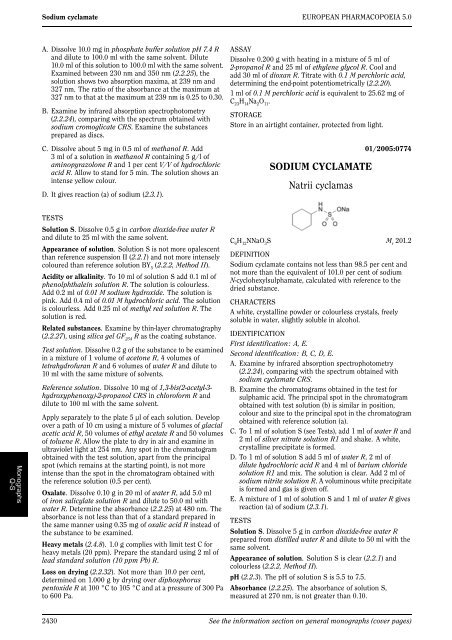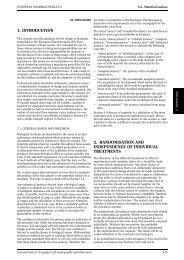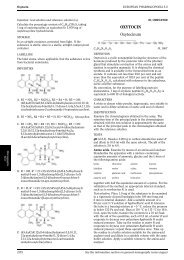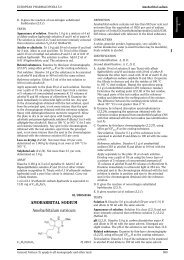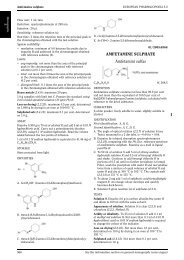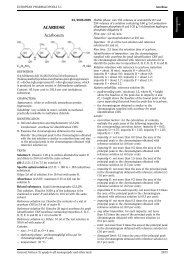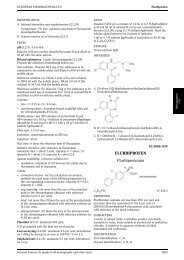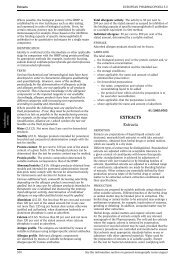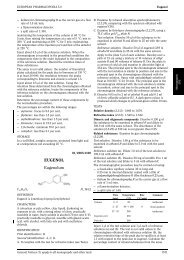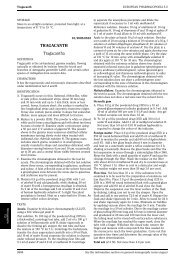SODIUM CYCLAMATE Natrii cyclamas
SODIUM CYCLAMATE Natrii cyclamas
SODIUM CYCLAMATE Natrii cyclamas
Create successful ePaper yourself
Turn your PDF publications into a flip-book with our unique Google optimized e-Paper software.
Sodium cyclamate EUROPEAN PHARMACOPOEIA 5.0<br />
A. Dissolve 10.0 mg in phosphate buffer solution pH 7.4 R<br />
anddiluteto100.0mlwiththesamesolvent.Dilute<br />
10.0 ml of this solution to 100.0 ml with the same solvent.<br />
Examined between 230 nm and 350 nm (2.2.25), the<br />
solution shows two absorption maxima, at 239 nm and<br />
327nm.Theratiooftheabsorbanceatthemaximumat<br />
327 nm to that at the maximum at 239 nm is 0.25 to 0.30.<br />
B. Examine by infrared absorption spectrophotometry<br />
(2.2.24), comparing with the spectrum obtained with<br />
sodium cromoglicate CRS. Examinethesubstances<br />
prepared as discs.<br />
C. Dissolve about 5 mg in 0.5 ml of methanol R. Add<br />
3mlofasolutioninmethanol R containing 5 g/l of<br />
aminopyrazolone R and 1 per cent V/V of hydrochloric<br />
acid R. Allow to stand for 5 min. The solution shows an<br />
intense yellow colour.<br />
D. It gives reaction (a) of sodium (2.3.1).<br />
TESTS<br />
Solution S. Dissolve 0.5 g in carbon dioxide-free water R<br />
and dilute to 25 ml with the same solvent.<br />
Appearance of solution. Solution S is not more opalescent<br />
than reference suspension II (2.2.1) and not more intensely<br />
coloured than reference solution BY5 (2.2.2, Method II).<br />
Acidity or alkalinity. To 10 ml of solution S add 0.1 ml of<br />
phenolphthalein solution R. The solution is colourless.<br />
Add 0.2 ml of 0.01 M sodium hydroxide. Thesolutionis<br />
pink. Add 0.4 ml of 0.01 M hydrochloric acid. Thesolution<br />
is colourless. Add 0.25 ml of methyl red solution R. The<br />
solution is red.<br />
Related substances. Examine by thin-layer chromatography<br />
(2.2.27), using silica gel GF254 R as the coating substance.<br />
Test solution.Dissolve0.2gofthesubstancetobeexamined<br />
in a mixture of 1 volume of acetone R, 4volumesof<br />
tetrahydrofuran R and 6 volumes of water R and dilute to<br />
10 ml with the same mixture of solvents.<br />
Reference solution. Dissolve 10 mg of 1,3-bis(2-acetyl-3hydroxyphenoxy)-2-propanol<br />
CRS in chloroform R and<br />
dilute to 100 ml with the same solvent.<br />
Apply separately to the plate 5 µl of each solution. Develop<br />
over a path of 10 cm using a mixture of 5 volumes of glacial<br />
acetic acid R, 50 volumes of ethyl acetate R and 50 volumes<br />
of toluene R. Allow the plate to dry in air and examine in<br />
ultraviolet light at 254 nm. Any spot in the chromatogram<br />
obtained with the test solution, apart from the principal<br />
spot (which remains at the starting point), is not more<br />
intense than the spot in the chromatogram obtained with<br />
the reference solution (0.5 per cent).<br />
Oxalate. Dissolve 0.10 g in 20 ml of water R, add5.0ml<br />
of iron salicylate solution R and dilute to 50.0 ml with<br />
water R. Determine the absorbance (2.2.25) at480nm.The<br />
absorbance is not less than that of a standard prepared in<br />
thesamemannerusing0.35mgofoxalic acid R instead of<br />
the substance to be examined.<br />
Heavy metals (2.4.8). 1.0 g complies with limit test C for<br />
heavy metals (20 ppm). Prepare the standard using 2 ml of<br />
lead standard solution (10 ppm Pb) R.<br />
Loss on drying (2.2.32). Not more than 10.0 per cent,<br />
determined on 1.000 g by drying over diphosphorus<br />
pentoxide R at 100 °C to 105 °C and at a pressure of 300 Pa<br />
to 600 Pa.<br />
ASSAY<br />
Dissolve 0.200 g with heating in a mixture of 5 ml of<br />
2-propanol R and 25 ml of ethylene glycol R. Cooland<br />
add 30 ml of dioxan R. Titratewith0.1 M perchloric acid,<br />
determining the end-point potentiometrically (2.2.20).<br />
1mlof0.1 M perchloric acid is equivalent to 25.62 mg of<br />
C 23H 14Na 2O 11.<br />
STORAGE<br />
Store in an airtight container, protected from light.<br />
<strong>SODIUM</strong> <strong>CYCLAMATE</strong><br />
<strong>Natrii</strong> <strong>cyclamas</strong><br />
01/2005:0774<br />
C 6H 12NNaO 3S M r 201.2<br />
DEFINITION<br />
Sodium cyclamate contains not less than 98.5 per cent and<br />
not more than the equivalent of 101.0 per cent of sodium<br />
N-cyclohexylsulphamate, calculated with reference to the<br />
dried substance.<br />
CHARACTERS<br />
A white, crystalline powder or colourless crystals, freely<br />
soluble in water, slightly soluble in alcohol.<br />
IDENTIFICATION<br />
First identification: A, E.<br />
Secondidentification:B,C,D,E.<br />
A. Examine by infrared absorption spectrophotometry<br />
(2.2.24), comparing with the spectrum obtained with<br />
sodium cyclamate CRS.<br />
B. Examine the chromatograms obtained in the test for<br />
sulphamic acid. The principal spot in the chromatogram<br />
obtained with test solution (b) is similar in position,<br />
colour and size to the principal spot in the chromatogram<br />
obtained with reference solution (a).<br />
C. To1mlofsolutionS(seeTests),add1mlofwater R and<br />
2mlofsilver nitrate solution R1 and shake. A white,<br />
crystalline precipitate is formed.<br />
D. To 1 ml of solution S add 5 ml of water R, 2mlof<br />
dilute hydrochloric acid R and 4 ml of barium chloride<br />
solution R1 and mix. The solution is clear. Add 2 ml of<br />
sodium nitrite solution R.Avoluminouswhiteprecipitate<br />
is formed and gas is given off.<br />
E. A mixture of 1 ml of solution S and 1 ml of water R gives<br />
reaction (a) of sodium (2.3.1).<br />
TESTS<br />
Solution S. Dissolve 5 g in carbon dioxide-free water R<br />
prepared from distilled water R and dilute to 50 ml with the<br />
same solvent.<br />
Appearance of solution. Solution S is clear (2.2.1) and<br />
colourless (2.2.2, Method II).<br />
pH (2.2.3). The pH of solution S is 5.5 to 7.5.<br />
Absorbance (2.2.25). The absorbance of solution S,<br />
measured at 270 nm, is not greater than 0.10.<br />
2430 See the information section on general monographs (cover pages)
EUROPEAN PHARMACOPOEIA 5.0 Sodium dihydrogen phosphate dihydrate<br />
Sulphamic acid. Examine by thin-layer chromatography<br />
(2.2.27), using a TLC silica gel G plate R.<br />
Test solution (a). Use solution S.<br />
Test solution (b). Dilute 1 ml of test solution (a) to 10 ml<br />
with water R.<br />
Reference solution (a). Dissolve 0.10 g of sodium<br />
cyclamate CRS in water R and dilute to 10 ml with the same<br />
solvent.<br />
Reference solution (b). Dissolve10mgofsulphamic acid R<br />
in water R anddiluteto100mlwiththesamesolvent.<br />
Apply to the plate 2 µl of each solution. Develop over a path<br />
of 12 cm using a mixture of 10 volumes of concentrated<br />
ammonia R, 10 volumes of water R, 20 volumes of ethyl<br />
acetate R and 70 volumes of propanol R. Drytheplateina<br />
currentofwarmair,heatat105°Cfor5minandspraythe<br />
hot plate with strong sodium hypochlorite solution R diluted<br />
to a concentration of 5 g/l of active chlorine. Place the plate<br />
in a current of cold air until an area of coating below the<br />
points of application gives at most a faint blue colour with<br />
adropofpotassium iodide and starch solution R; avoid<br />
prolonged exposure to cold air. Spray with potassium iodide<br />
and starch solution R and examine the chromatograms<br />
within 5 min. Any spot corresponding to sulphamic acid<br />
in the chromatogram obtained with test solution (a) is not<br />
more intense than the spot in the chromatogram obtained<br />
with reference solution (b) (0.1 per cent).<br />
Aniline, cyclohexylamine and dicyclohexylamine. Not<br />
more than 1 ppm of aniline, not more than 10 ppm<br />
of cyclohexylamine and not more than 1 ppm of<br />
dicyclohexylamine determined by gas chromatography<br />
(2.2.28) usingtetradecane R as the internal standard.<br />
Internal standard solution. Dissolve 2 µl of tetradecane R<br />
in methylene chloride R anddiluteto100mlwiththesame<br />
solvent.<br />
Test solution. Dissolve 2.00 g of the substance to be<br />
examined in 20 ml of water R and add 0.5 ml of strong<br />
sodium hydroxide solution R and shake with 30 ml of<br />
toluene R. Shake 20 ml of the upper layer with 4 ml of a<br />
mixture of equal volumes of dilute acetic acid R and water R.<br />
Separate the lower layer and add 0.5 ml of strong sodium<br />
hydroxide solution R and 0.5 ml of the internal standard<br />
solution. Shake and use the lower layer for chromatography<br />
immediately after separation.<br />
Reference solution. Dissolve10.0mg(about12µl)<br />
of cyclohexylamine R, 1.0mg(about1.1µl)of<br />
dicyclohexylamine R and 1.0 mg (about 1 µl) of aniline R<br />
in water R and dilute to 1000 ml with the same solvent.<br />
Dilute 10.0 ml of this solution to 100.0 ml with water R<br />
(solution A). To 20.0 ml of solution A, add 0.5 ml of strong<br />
sodium hydroxide solution R and extract with 30 ml of<br />
toluene R. Shake 20 ml of the upper layer with 4 ml of a<br />
mixture of equal volumes of dilute acetic acid R and water R.<br />
Separate the lower layer and add 0.5 ml of strong sodium<br />
hydroxide solution R and 0.5 ml of the internal standard<br />
solution. Shake and use the lower layer for chromatography<br />
immediately after separation.<br />
The chromatographic procedure may be carried out using:<br />
— a fused silica column 25 m long and 0.32 mm in internal<br />
diameter coated with poly(dimethyl)(diphenyl)siloxane R<br />
(0.51 µm),<br />
— helium for chromatography R as the carrier gas at a flow<br />
rate of 1.8 ml/min,<br />
— a flame-ionisation detector,<br />
— asplitventataflowrateof20ml/min,<br />
withthefollowingtemperatureprogramme:<br />
Time<br />
(min)<br />
Temperature<br />
(°C)<br />
Rate<br />
(°C/min)<br />
Comment<br />
Column 0-1 85 isothermal<br />
1-9 85→150 8 linear gradient<br />
9-13 150 isothermal<br />
Injection port 250<br />
Detector 270<br />
Inject 1.5 µl of each solution. When the chromatograms are<br />
recorded in the conditions prescribed, the retention times<br />
relative to cyclohexylamine (about 2.3 min) are the<br />
following: aniline about 1.4, tetradecane about 4.3 and<br />
dicyclohexylamine about 4.5.<br />
Sulphates (2.4.13). Dilute 1.5 ml of solution S to 15 ml with<br />
distilled water R. The solution complies with the limit test<br />
for sulphates (0.1 per cent).<br />
Heavy metals (2.4.8). 12 ml of solution S complies with limit<br />
test A for heavy metals (10 ppm). Prepare the standard using<br />
lead standard solution (1 ppm Pb) R.<br />
Loss on drying (2.2.32). Not more than 1.0 per cent,<br />
determined on 1.000 g in an oven at 100 °C to 105 °C for 4 h.<br />
ASSAY<br />
Dissolve without heating 0.150 g in 60 ml of anhydrous<br />
acetic acid R.Titratewith0.1Mperchloric acid,determining<br />
the end-point potentiometrically (2.2.20).<br />
1mlof0.1 M perchloric acid is equivalent to 20.12 mg of<br />
C6H12NNaO3S. IMPURITIES<br />
A. sulphamic acid,<br />
B. aniline (phenylamine),<br />
C. cyclohexanamine,<br />
D. N-cyclohexylcyclohexanamine.<br />
01/2005:0194<br />
<strong>SODIUM</strong> DIHYDROGEN PHOSPHATE<br />
DIHYDRATE<br />
<strong>Natrii</strong> dihydrogenophosphas dihydricus<br />
NaH2PO4,2H2O Mr 156.0<br />
DEFINITION<br />
Sodium dihydrogen phosphate dihydrate contains not less<br />
than 98.0 per cent and not more than the equivalent of<br />
100.5 per cent of NaH2PO4, calculated with reference to the<br />
dried substance.<br />
GeneralNotices(1)applytoallmonographsandothertexts 2431


